फॉल आर्मीवोर्म: भारत में आक्रमक रूप में पाए जाने वाली मक्का की कीट तथा उनका प्रबंधन
Invasive pests are non-native or exotic organisms and they are also called introduced species or alien species. The Fall Armyworm, Spodoptera frugiperda, (J. E. Smith) (Lepidoptera: Noctuidae) is an insect native to tropical and subtropical regions of the Americas. The FAW caterpillars feed on the leaves, stems and reproductive parts of more than 100 plant species (CABI 2017).
The entry of an invasive pest, Fall Armyworm in India was reported first time by Dr. Sharanabasappa and Dr. Kalleshwara Swamy on 18th May, 2018 in Maize fields at College of Agriculture, University of Agricultural and Horticultural Sciences (UAHS), Shivamogga, Karnataka.
After that, it was reported in Tamil Nadu, Telangana, Andhra pradesh, Maharashtra on sugarcane and other Indian states Bihar, Chhattisgarh, Gujarat, Orissa and West Bengal on maize crops.
Life cycle of Fall armyworm
- The fall armyworm has four stages in the life cycle like egg, larva, pupa and adult. Life cycle is completed within 30 days during summer, and 60 days during the spring and autumn seasons. FAW found throughout the year and having 6 to 11 generations per year depending upon temperature (Luginbill, 1928).
- Eggs are laid as ‘egg masses’ in batches of 100–200 eggs underside and upperside of leaves and potential fecundity of up to 2,000 eggs per female that hatch in 2 to 5 days in optimum temperatures.
- Larval duration is 14 to 28 days and the development take place between 11°C to 30°C. Larva cannot enter into diapause, they cannot survive cold temperature.
- Pupal stage lasts for 7 to 14 days and survives at the temperature range of 18-24°C.
- Adults are nocturnal, and are most active during warm, humid evenings. After a pre-oviposition period of 3 to 4 days, the female moth normally deposits most of her eggs during the first 4 to 5 days of life, but some oviposition occurs for up to 3 weeks.
- Duration of adult life is estimated to average about 10 days, with a range of about 7-21 days.Adult moth can migrate with a capacity of 100 km over night and 300 miles per generation.
- The incidence of cannibalism of larval Spodoptera frugiperda (Lepidoptera: Noctuidae) was found to account for approximately 40% mortality when maize plants were infested with two or four fourth-instar larvae over a 3-day period. (Chapman et al. 2000)
Marks of identification
Egg is dome shaped and adult females lay eggs on the lower leaves. They change from green to light brown before hatching. Eggs are covered in protective scales rubbed off from the moths abdomen. Larvae is vary in colour from pale green to almost black, three yellowish stripes running down the back, four tubercles in square manner on the 8th abdominal segment and dark head with a pale, upside-down Y-shape on the front. The mature caterpillar drop down to ground and makes an earthen cell by constructing cocoon of sand particles mixing with silk.
The pupa is shiny reddish brown in colour. In the adult male moth, the forewing generally shaded gray and brown, with triangular white spots at the tip and orange spot near the canter of the wing. The forewings of females are less distinctly marked, ranging from a uniform greyish brown. Female is slightly bigger than male.
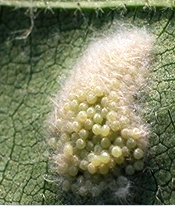

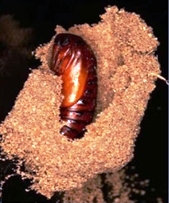
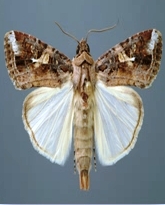
Nature of damage
Young larvae usually feed on leaves, creating a characteristic “windowing”. Young caterpillars can spin silken threads which catch the wind and transport the caterpillars to a new plant.
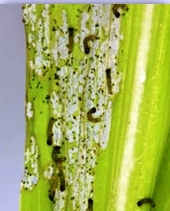

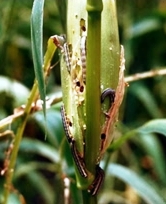
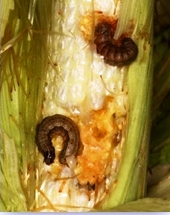
Feeding through the maize whorl can cause a line of irregular “shot” holes, when the leaf unfurls and moist sawdust like frass near the funnel. As the caterpillars mature, also damage the reproductive parts by burrowing into cobs and feed on the tassels and kernels.
Management of Fall armyworm
SCOUTING
- Start scouting as soon as maize seedlings emerge. At Seedling to early whorl stage (3-4 Weeks after emergence).
- Action can be taken if 5% plants are damaged.
- At Mid whorl to late whorl stage (5-7 weeks after emergence) - Action can be taken if 10 % whorls are fleshly damaged in mid whorl stage and 20% whorl damage in late whorl stage.
- At tasseling and post tasseling (Silking stage) - Do not spray insecticides. But 10% ear damage needs some ecofrendly (collection and destruction of egg and larvae) action. ( ICAR recommendation 2019)
CULTURAL CONTROL:
- Early planting to avoid periods of high pest densities and avoid staggered planting (i.e. planting of fields at different dates in the same area), as this would continue to provide the favoured food of FAW locally (i.e. young maize plants).
- Deep ploughing will expose the pupae to natural enemy.
- Crop rotation with non-host plants and varietal choice may well contribute to reducing pest pressure.
- Collection and destruction of egg masses and different stages of larvae, it is advisable to burn stubbles and cuttings after harvesting on infested fields. This will kill both the un-hatched eggs, larvae, pupae and adults left on the field at harvest.
- Erection of bird perches @ 10/acre during early stage of the crop.
- Implementing the push-pull technology, this technology entails using a repellent intercrop (Desmodium as a “push”) and an attractive trap plant shown as border crop (Napier grass as a “pull”).
- Clean cultivation of maize advisable for management of fall armyworm and balanced used of fertilizers.
- Good soil health and adequate moisture are critical: They are essential to grow healthy plants, which can better withstand pest infestation and damage. (ICAR recommendation 2019)
- Spraying with sugar solution may be a low-cost option for encouraging natural enemies into the crop. Sugar on leaves attracts ants, solitary wasps, parasitoids and other natural enemies. The electiveness of such a measure will depend on the availability of natural enemies around the field.
MECHANICAL AND LOCAL CONTROLS:
- A very important management option for smallholder farmers, based on the experience of smallholders in the Americas, is to visit their fields regularly, and crush egg masses and young larvae.
- Farmers should visit fields twice a week during vegetative stage, especially in periods of heavy oviposition by FAW, and once a week or every 15 days in later stages.
- Some smallholder farmers in the Americas report using ash, sand, sawdust or dirt into whorls to control FAW larvae (Dirt may contain entomopathogenic nematodes, Nucleopolyhedrosis Virus (NPV), or bacteria (such as Bacillus spp.) that can kill FAW larvae).
- Finally, it is also reported picking larvae to feed them to chicks for poultry production.
- FAW are also edible for human consumption. In countries where insects are consumed, they can be a good complementary source of protein for local population. (ICAR recommendation 2019)
Monitoring and mass trapping of pest:
For pest monitoring and mass trapping: Installation of pheromone traps @ 5/acre and use light trap @ one / ha during night hours to monitor the adult moth activity in and around maize fields. Mass trapping of male moths using pheromone traps @ 15/acre. (ICAR recommendation 2019)
For mass trapping: For effective management of fall army worm in maize, the farmers are advised to install 50 sex pheromone traps per hectare and the lure will be changed after 40 days. (JAU recommendation 2019)
PHYSICAL CONTROL:
Arthur et al. (2016) found that when the last instars were irradiated with 200Gy, the pupation rate was reduced to 30 percent and adult emergence was reduced to 10 percent, and all of the adults that emerged were deformed, unableto fly, and died after about 2h. Therefore, irradiation with 200 Gy is recommended as the appropriate dose for phytosanitary irradiation of frugiperda eggs and larvae, this research was conducted with last instar larvae with the understanding that a dose that controls last instar will control the preceding instars and the eggs.
BIOLOGICAL CONTROL
- In situ protection of natural enemies by habitat management: increase the plant diversity by intercropping with pulses and ornamental flowering plants which help in build-up of natural enemies.
- FAW eggs, larvae, and pupae are attacked by several species of parasitoids. Among several groups of parasitoids, the egg parasitoids Telenomus and Trichogramma sp. are deemed important in several countries.
- These egg parasitoids Trichogramma sp. and Telenomus are easy to rear under laboratory conditions.
- However, the presence of scales/hairs over the egg masses acts as a barrier against parasitism by Trichogramma spp. but not to Telenomus spp. This physical barrier could be overcome by selecting a more aggressive species of Trichogramma, capable of breaking the physical barrier imposed by scales on the eggs for biological control of the FAW.
- Augmentative release of Tricogramma pretisonum or Telenomus remus @ 50,000 per acre at weekly intervals. (ICAR recommendation 2019)
MICROBIAL BIOPESTICIDES
For effective management of fall army worm in maize, the farmers are advised to apply three sprays of Beauveria bassiana 15 WP (2 X 10 6 cfu/g) 0.009 % (80 g/10 l of water) OR Nomuria rileyi 1.15 WP (2 X 10 6 cfu/g) 0.007 % ( 60 g/10 l of water) + SfNPV 450 LE (10 ml/10 l of water). First at initiation of pest infestation and subsequent two sprays at 10-day interval. (JAU recommendation 2019)
Entomopathogenic fungal formulations:
- Biopesticides: Suitable at 5% damage in seedling to early whorl stage and l0% ear damage with entomopathogenic fungi and bacteri
- Application of Metarhizium anisopliae talc formulation (1 x 108 cfu/g) @ 5 g/litre whorl application at 15-25 days after sowing. Another l -2 sprays may also be given at an interval of 10 days depending on pest damage or Nomuraea rileyi rice grain formulation (1 x 108 cfu/g) @ 3 g/lilre whorl application at 15-25 days after sowing. Another 1-2 splays may also be given at an interval of 10 days depending on pest damage.
- Bacillus thuringiensis kurstaki formulations @ 2g/l (or) 400g/acre. (ICAR recommendation 2019)
BOTANICALS CONTROL
- Spray with 5% NSKB or azadirachtin 1500 ppm as soon as the trap crop shows symptom of FAW damage. (ICAR recommendation 2019)
- Extracts of many plants like neem (Azadirachtin), piperine extract, jetropha and pyrethrum (pyrethrins) show insecticidal activity against FAW and the most widely found product.
- Azadirachtin 1 EC @ 20 ml / 10 lit. also effective.
CHEMICAL CONTROL
For effective management of fall army worm in maize, the farmers are advised to apply two sprays of emamectin benzoate 5% SG 0.0025 % (5g/10 l of water) OR thiodicarb 75% WP 0.075 % (10 g/10 l of water) OR spinetoram 11.7% EC 0.012 % (10ml/10 l of water). First at initiation of pest infestation and second at 10-day interval. (JAU recommendation 2019)
Seed treatment:
With Cyantraniliprole 19.8% + Thiomethoxam 19.8% @ 4 ml per kg seed reported to offer protection up to 2-3 weeks after germination. Formulation is not registered in India and also has not been evaluated in AICRP programme. However, based on the feedback from seed growers this insecticide is giving protection. for 2- 3 weeks after germination)
First Window (seedling to early whorl stage):
To control FAW larvae at 5% damage to reduce hatchability of freshly laid eggs, spray 5% NSKE / Azadirachtin 1500 ppm @ 5ml/l of water.
Second window (mid whorl to late whorl stage):
To manage 2nd and 3d instars larvae at 10-20% damage spray Emamectin benzoate @ 0.4 g/l of water OR Thimethoxam 12.6% + lambda cyhalothrin 9.5% EC @ 0.5 ml/l of water OR Chlorantraniliprole 5% SC @ 0.3 ml/l of water.
Poison baiting:
Poison baiting is recommended for late instar larvae of second window. Keep the mixture of 10 kg rice bran + 2kg jaggery with 2-3 litres of water for 24 hours to ferment. Add l00g thiodicarb just half an hour before application in the field. The bait should be applied into the whorl of the plants.
Third Window (8 weeks after emergence to tasseling and post tasseling):
Insecticide management is not cost effective at this stage. Hand picking of the larvae is advisable.
Note: All the sprays should be ditected towards whorl and either in the early hours of the day or in the evening time. (ICAR recommendation 2019)
INNOVATIVE APPROACHES FOR AWARENESS AMONG THE FARMERS
Farmer Field Schools (FFS): Farmer education and community action are important elements in the strategy to best manage FAW populations. Sound understanding of biology and ecology of the pest, monitoring at community and field level and fine-tuning management strategies underpin community action.
Organizing Prize Competitions: Food and Agriculture organization has arranged fall armyworm Tech Prize competition for supporting innovation and strategies for the better control of fall armyworm.
Mobile Applications: Different mobile applications which provides identification guideline about the pest such as “Plantvillage Nuru”. ( FAO, 2017)
CAPACITY BUILDING AND MASS AWARENESS
- Application and timely plant protection measures to avoid spread of the insect from the abandoned crop.
- Creation of awareness among important stake holders through trainings /group discussions.
- Community based and area-wide approach for implementing management strategies.
Reference:
CABI, 2017. Fall Armyworm: Impacts and Implications for Africa. Evidence Note (Summary Version), September 2017. www.invasive-species.org/fawevidencenote.
Luginbill, P. (1928). The Fall Armyworm. USDA Technical Bulletin 34.pp 91.
Arthur, V.; Arthur, P. B. and Machi, A. R. (2016). Pupation, adult emergence, and F1 egg hatch after irradiation of Spodoptera frugiperda (Lepidoptera: Noctuidae) last instars. Florida Entomologist, 99 (2):59-60.
Authors
Bavisa Rupa V.1, Ginoya Aarti V.2 and Delvadiya Indrajay R.
Department of agricultural entomology 1, Seed science and technology2, Genetics and plant breeding
College of agriculture, Junagadh agriculture university, junagadh (362001) Gujarat, India
E-mail-
